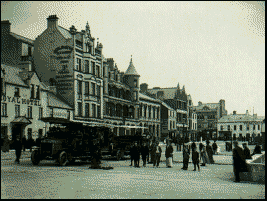 Bangor takes its name from the Gaelic 'Beannchor' which in turn is derived from 'beanna' (peaks) and 'chor' (curve), presumed by scholars to refer to Bangor Bay.
Bangor takes its name from the Gaelic 'Beannchor' which in turn is derived from 'beanna' (peaks) and 'chor' (curve), presumed by scholars to refer to Bangor Bay. There were probably settlements around Bangor and Ballyholme Bays before the establishment by St Comgall, about 558AD, of an abbey which became one of the most important in early Christian Europe. Plundered by the Vikings, the Abbey was restored by St Malachy in the 12th century only to become vacant once more at the Dissolution in 1572. About this time also, 'the whole great Ardes was split between James Hamilton and Hugh Montgomery 'that the sea coast might be possessed by Scottish men who would be traders',(1)
Montgomery being based at Newtownards and Hamilton at Bangor. Sir James Hamilton, who was to become Viscount Clandeboye was accompanied by Scots from Dunlop in Ayrshire who began the process of creating the Town of Bangor.
In 1625, Hamilton commissioned Thomas Raven to prepare maps of his lands at Clandeboye. One of these shows an informal layout to the Town with two principal streets, the present lower Main Street and High Street, development along the shore linking them and a third street parallel to Main Street. The church, the castle and a mill can be identified and a rabbit warren occupies the Kinnegar.
The Ordnance Survey Memoirs of 1837 state that 'the cottages are principally built of stone, mostly thatched but in many cases slated; with a few exceptions they are but one storey high. Glass windows are in all cases employed and a tolerable degree of cleanliness and neatness may be seen to prevail in some instances.'
Cotton manufacturing had been introduced to the town in 1783 and mills were built in the lower High Street area and on the site of the Sunken Gardens .....'two large cotton factories with their smokey chimneys form the most striking features and the whole place has a manufacturing, crowded and dirty appearance'. By 1860 however the Valuation Survey records the New Mill as 'dilapidated' and the Old Mill had become a store.
In 1834, 2741 people lived in 507 houses in the Town which was managed by a Corporation composed of members of the Ward family (descendants of Sir James Hamilton). In 1865, wells were sunk in Ballymagee Street (High Street), Holborn Avenue and Main Street; reservoirs were built in 1881 and 1891; main drainage was provided in 1882 and electricity arrived in 1930.
The arrival of the Belfast, Holywood and Bangor railway, in 1865, brought about the development of Bangor as a major seaside resort. This 'northern Brighton' could be reached by road, rail or steamer and 'the chastely designed elegant villas were overspreading the landscape and occupying hill and vale and points of vantage on every side, rising tier upon tier in varied architectural style and crowning the heights, which, on the land side, encompass it like the arc of an amphitheatre'(2). The development of Ballyholme, where there was a long sandy beach, followed towards the end of the century. Bangor's development in the l9th century was very much based on the sea, whether for business or pleasure, and, as the resort developed, the Town created tourist facilities such as the Esplanade, at the foot of High Street, to attract summer visitors. In 1905 the seafront round to Stricklands Glen was acquired by Act of Parliament followed by Ballyholme Park in 1907, Ward Park in 1909 and eventually Stricklands Glen itself.
Commercial enterprises also catered for tourists, from the Grand Hotel built on the Promenade in the 1890's to the largest cinema in Ireland, the Tonic. With two golf courses, tennis courts, putting, bowls, bathing and a dance hall, Bangor was the ideal place for holidays during the inter-war years.
The post-war period saw the continued growth of Bangor as a dormitory town for Belfast. At the same time changing holiday trends were leading to a decline in the Town's traditional role as a seaside resort.